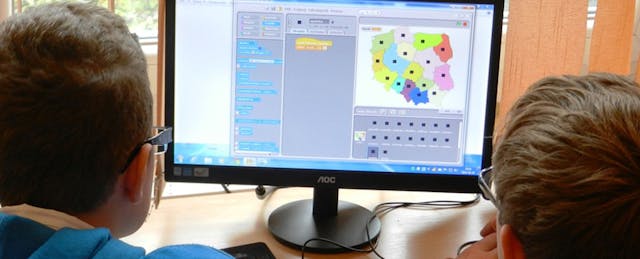Project-Based Learning (PBL) is one of the hottest buzzwords in education, and it’s easy to see why.
PBL combines standards-based curriculum with empowering students to solve real world challenges. Through projects, students master skills—critical thinking, creativity, communication, and collaboration—that are hard to teach in traditional classrooms. Some project-based schools even report 20% higher standardized test scores than those with conventional classrooms.
As a co-founder of CrowdSchool, a PBL platform, I’ve spent nearly two years talking with teachers, schools, and districts about how to make it easier to teach with PBL. Despite the mounting evidence and excitement for project-based learning, only roughly 1% of US schools are committed to teaching with it. So why is PBL having such a problem with scale? And what can we do to address wider adoption?
Here are 4 ideas to bring project-based learning into mainstream education:
1. Create Plug-and-Play Parts
PBL in its current form is too “do-it-yourself.” For PBL to scale into mainstream education, we need more efficient tools and readymade ingredients to empower time-strapped teachers to make PBL a habit that sticks.
Imagine making lasagna. Now, imagine making lasagna like your Italian grandmother would—starting from scratch by making noodles by hand. This is a perfect picture of what most teachers face when teaching through projects.
In a recent survey, teachers using CrowdSchool reported that, even after significant training, it can initially take three times more time to plan and organize projects than teaching with a traditional lecture and test format. Yet, many teachers persevere with PBL because of the amazing ways that PBL sparks a sense of purpose and ownership in their student learners.
Like your grandmother’s lasagna, handmade PBL is well-received by those fortunate enough to try it, but too time consuming for most teachers to try—unless they have the tools to do the job.
2. Promote Communities of Practice
John Larmer, Editor-in-Chief at the Buck Institute for Education, says that expecting educators to adopt PBL is not just asking them to make lasagna from scratch. “It's like asking someone to make lasagna who's never eaten it, just heard it's good,” he says. Larmer believes the challenge is that, “teachers didn't experience [PBL] when they were in school, and they naturally tend to teach like they were taught.”
How, then, can we create new models to give educators and students a taste of PBL?
We need ways for teachers to share their best project-based ideas and a place for students to show off their inspiring student work. PBL promotes student collaboration and teamwork, so teachers should have that same experience.
For example, on Twitter, #PBLchat is a place where educators meet weekly to share exchange ideas and best practices. Additionally, the Buck Institute curates a Project Search with links to project-based lessons posted on the internet, as well as a PBL discussion community on Edmodo.
By establishing PBL communities, educators breakdown the silos that exist in those pockets of progressive schools. It gives a voice to a group, it empowers educators to experience what is possible, and establishes best practices that everyone can learn from.
3. Inspire A Cultural Shift with Professional Development
John Larmer points out that traditional school culture was set up in the 1890s to "deliver content" like assembly lines in factories. Creating schools where PBL can thrive requires a cultural shift. As a result, Larmer’s Buck Institute and others deliver professional development to schools and districts to help them create a cultural shift in the classroom.
Asking someone to start a movement is a daunting task. After learning the basics of PBL, teachers may understand the strategy—but implementing the tactics is a whole new experience. Thus, asking someone to join a movement is a more effective way to create PBL culture in the classroom. Creating that environment, providing a roadmap, and nurturing the PBL experience will leverage the investment in professional development and lead to more successful outcomes.
“The truth about PBL is, that once you learn the skills, culture and best practices, you find you are teaching the way you always dreamed you would,” says Ryan Steuer, Executive Director at Magnify Learning, a network that offers professional development for PBL to schools and districts.
For those who make the investment in training and culture, Steuer believes there is a big payoff. “We join education to change the lives of kids for the better and to give them a future they could have never imagined on their own. I have seen PBL do that through school cultures providing authentic projects connected to strong community partners.”
4. Teach 21st Century Skills with 21st Century Technology
While worth the investment, creating a new culture can take considerable training which can cost a school tens of thousands of dollars.
Many administrators I have spoken with also say that even after training, efficacy of instruction can be challenging to maintain beyond the first few months. When schools adapt current tools to teach PBL, it can be a mix of paper-based outlines, assignment postings on a class page, and custom interfaces. In the end, teaching 21st century skills is relegated to old and time consuming methods.
At Crowdschool, we believe that technology tailored to PBL can dramatically reduce the costly time and training currently required for PBL. By addressing the issues listed above, we empower educators to intuitively create curriculum, assess student learning, share PBL ideas, and showcase student work to authentic audiences online.
What ideas have worked for scaling PBL adoption in your school or district?


